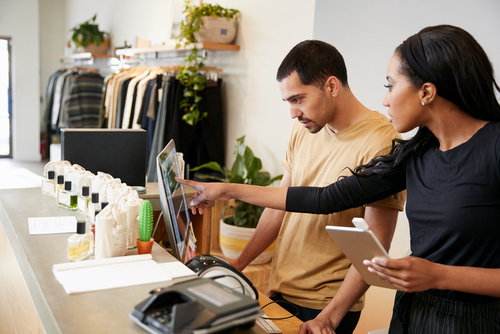What are Point of Sale Displays?
If you have ever been shopping and decided, at the last moment, you just had to add the cute purse-sized air freshener or the bargain-priced chocolate bar to your purchase, you have been targeted by point of sale displays. You aren’t alone; statistics tell us that 66 percent of all purchasing decisions are made while the shopper is in the store and 55 percent of those are what we call, “impulse buys.”
What are Point of Sale Displays?
These displays, also known as point of purchase, are end cap, cardboard or other movable displays of a product or category of product. According to “Small Business. Chron,” they highlight specific brands or showcase added-value promotions. Usually, these are offered in the area where the cash register is located. Graphic designers make sure they are visually arresting, and the displays must be changed frequently to stay effective. Many small stores such as convenience outlets attached to gas stations, get the displays from the manufacturer or distributor but sales staff service them. In some cases, manufacturer’s sales reps travel between stores rotating stock and changing the displays in exchange for keeping their products at the forefront. Common items for point of purchase are gum, candy, sodas, and souvenir-type items. Coffee and snack islands are another type of point of purchase display. They aren’t necessarily located adjacent to the register, but they are close enough to entice the shopper to grab a cup of coffee or a donut on their way out.
Why Do They Work?
Manufacturers employ psychologists to study buying habits. They use eye-tracking and movement-tracking to study how people shop. Those studies have shown that customers are often overwhelmed with the number of brands stores offer and with the amount of visual data that bombards them. “Boundless. Com” says that a supermarket may contain more than 20,000 brands and millions of visual stimuli. In addition, people spend only about a minute per aisle. If each aisle contains six categories of products, for instance floor cleaners, carpet spot removers, air fresheners, upholstery cleaners, mops and brooms and waxes, and then has ten brands of each product, the attention the shopper gives to each brand is only one second. Those two concerns, the brevity of time shoppers spend and the amount of stimuli that accosts them in that time, overwhelm shoppers so that they don’t even see the majority of a store’s stock. Manufacturers are savvy to this and bring their products to the forefront with point of purchase displays.
Is Technology Used in The Displays?
Of course, the brighter and more interactive a display is, the more attention it will garner. LED displays and other visuals are beneficial. Technology brings a new face to point of purchase, however. Merchants record their customer’s email address and mobile phone number digitally. Utilizing the GPS system in the phones, they track when the customer is near the store and send coupons or offers that can be redeemed immediately. Pop-ups appear on phone-shoppers’ screens suggesting go-with purchases, and images of desserts come up when people order a meal, making it more possible that customers will think about pie a la mode.
Most people grab that frosty soda or the conveniently placed magazine as they head to the checkout, without thinking about the reasoning behind it. It’s founded on good science, and point of sale displays work.
Related Resources:
